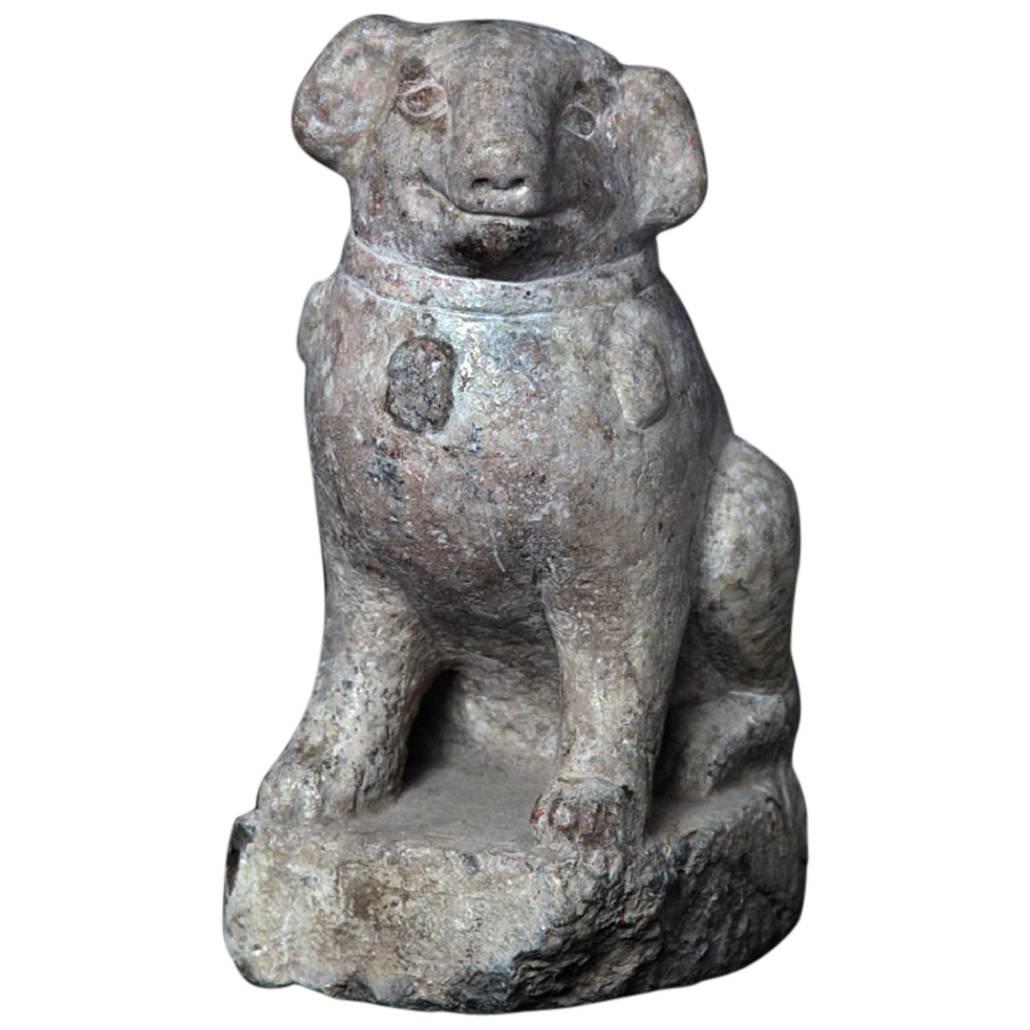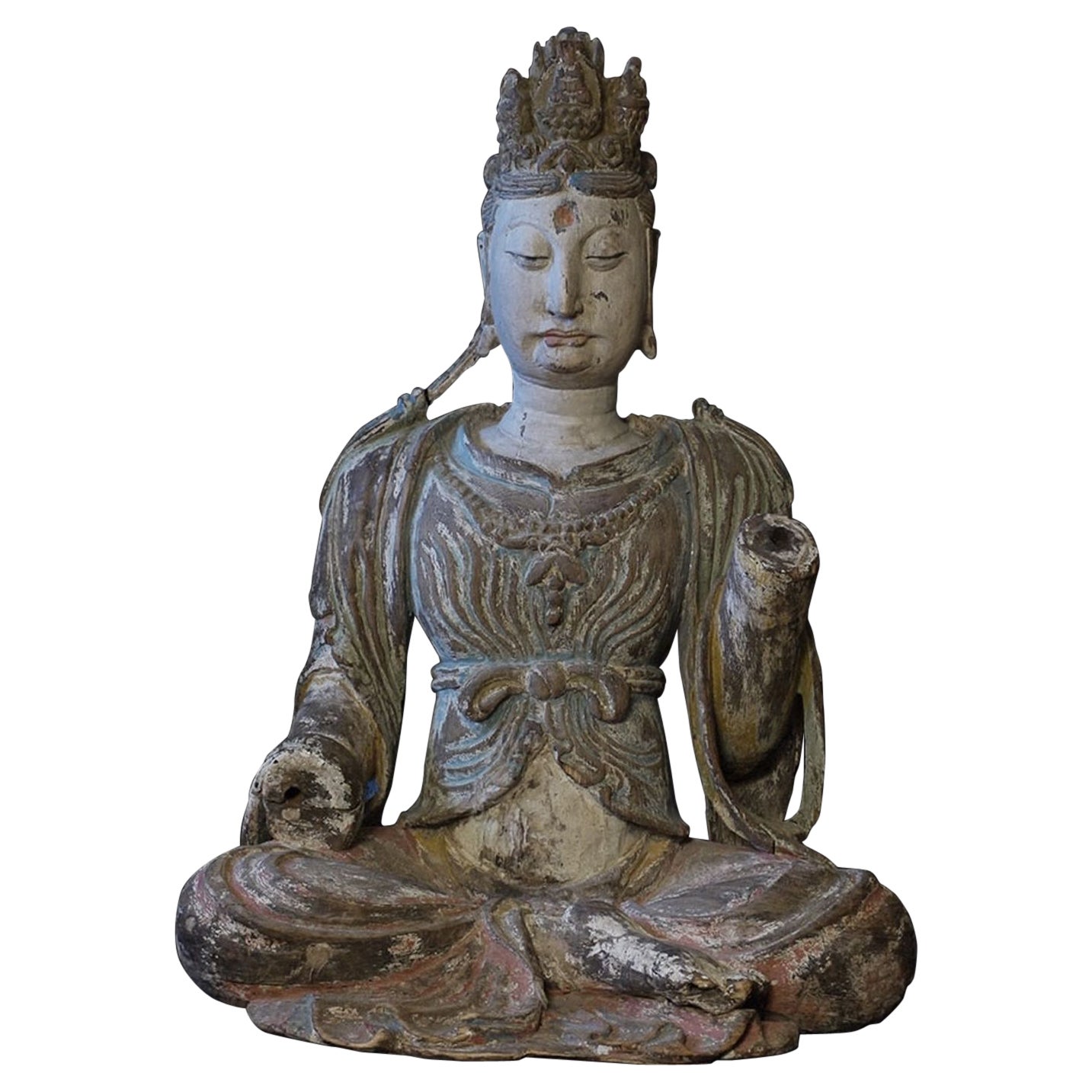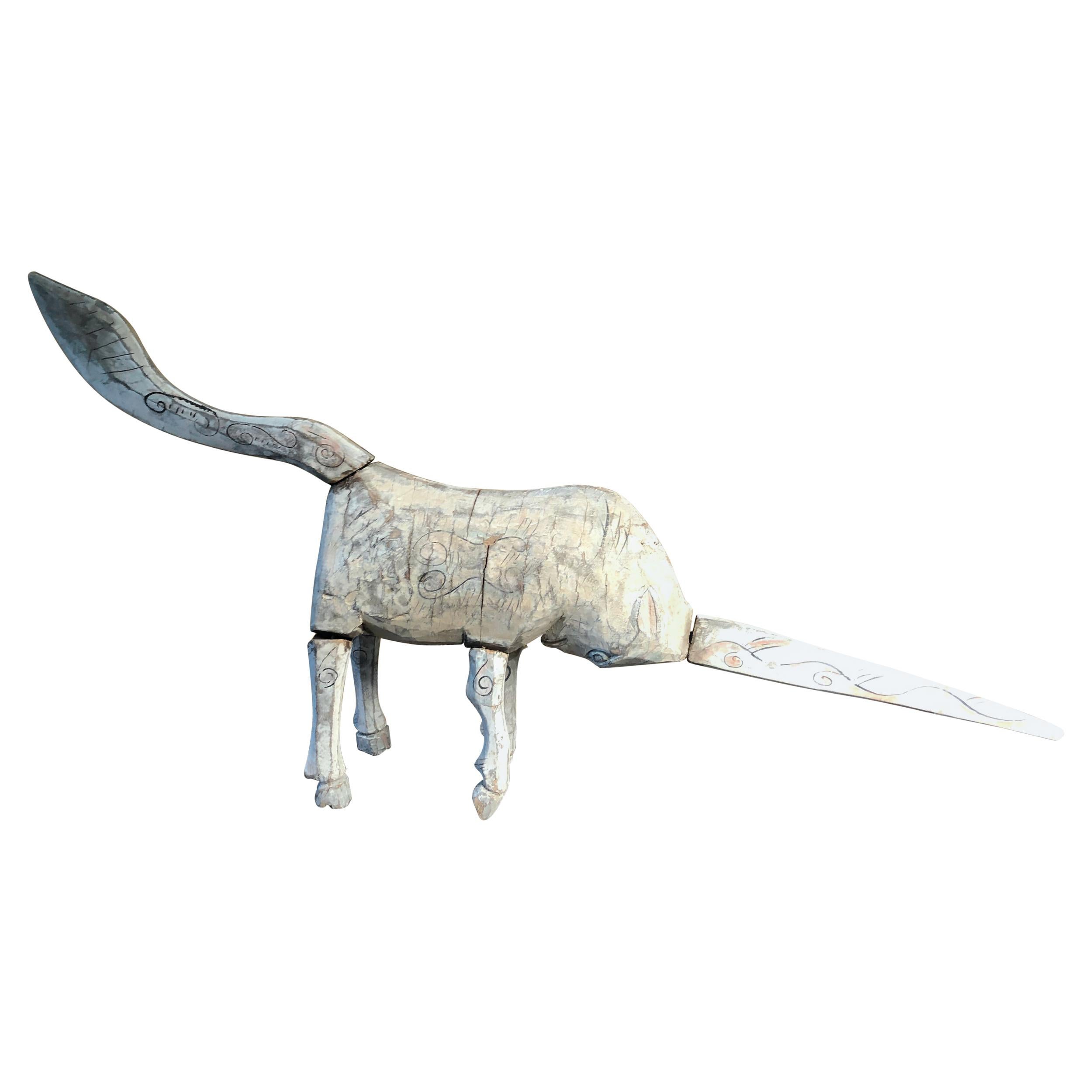Items Similar to Three Ancient Terracotta Sculptures, China Ming Period
Want more images or videos?
Request additional images or videos from the seller
1 of 6
Three Ancient Terracotta Sculptures, China Ming Period
About the Item
This Chinese terracotta group of figures is made up of three figures of Chinese dignitaries in glazed green and ocher terracotta on hexagonal bases and removable heads.
From the dresses with wide sleeves and workmanship, as well as from the cylindric flat hats, we understand that the statues are of Chinese origin, Ming Era. Good conditions.
This object is shipped from Italy. Under existing legislation, any object in Italy created over 70 years ago by an artist, designer or craftsman who has died requires a license for export regardless of the work’s market price. The shipping may require additional handling days to require the license according to the final destination of the object.
- Dimensions:Height: 1.19 in (3 cm)Width: 18.51 in (47 cm)Depth: 36.23 in (92 cm)
- Sold As:Set of 3
- Materials and Techniques:
- Place of Origin:
- Period:
- Date of Manufacture:16th Century
- Condition:Wear consistent with age and use. This Chinese terracotta lot is made up of three figures of Chinese dignitaries in glazed green and ocher terracotta on hexagonal bases and removable heads. From the dresses with wide sleeves and workmanship, as well as from the cylindric flat hats,.
- Seller Location:Roma, IT
- Reference Number:
About the Seller
4.8
Platinum Seller
These expertly vetted sellers are 1stDibs' most experienced sellers and are rated highest by our customers.
Established in 2015
1stDibs seller since 2017
829 sales on 1stDibs
Typical response time: 5 hours
- ShippingRetrieving quote...Ships From: Rome, Italy
- Return PolicyA return for this item may be initiated within 14 days of delivery.
More From This SellerView All
- Pair of Ancient Blue Terracotta Vases, by Oriental Manufacture, 19th CenturyLocated in Roma, ITThese pair of blue vases is an original decorative terracotta object realized in the second half of the 19th century by Oriental manufacture. A beautiful couple of terracotta vase...Category
Late 20th Century Asian Antiquities
MaterialsTerracotta
- Vintage Chinese Serpentine Sculpture, China, Early 20th CenturyLocated in Roma, ITVintage Chinese serpentine sculpture is a traditional decorative object realized in china in the early 20th century. Serpentine m...Category
Early 20th Century Japanese Figurative Sculptures
MaterialsMarble, Serpentine
- Ancient Japanese Kutani Vases, 19th CenturyLocated in Roma, ITThese Japanese Kutani Vases are refined decorative objects realized by a Japanese artist in the 19th century. This beautiful set includes two ...Category
Antique 19th Century Japanese Vases
MaterialsCeramic
- Ancient Bronze Head of Buddha, 19th CenturyLocated in Roma, ITBeautiful ancient bronze head of Buddha, late 19th century. Good conditions, it rests on a green marble base. This artwork is shipped from Italy. ...Category
Antique 19th Century Asian Figurative Sculptures
MaterialsBronze
- Polychrome Chinese Porcelain Box with Lid, China, Early 20th CenturyLocated in Roma, ITThis polychrome porcelain box and cover is a superb decorative object, realized in China in the early 20th century. The domed lid is decorated with a scene depicting a boy on a my...Category
Early 20th Century Chinese Antiquities
MaterialsPorcelain
- Vintage Chinese Porcelain Plate, Made in China, Early 20th CenturyLocated in Roma, ITThis porcelain plate is an original decorative object realized in China by Chinese manufacture, at the beginning of the 20th century. It is decorated with geometric and floral or...Category
Early 20th Century Chinese Antiquities
MaterialsCeramic
You May Also Like
- Important Ancient Chinese Effigy Pug Dog, Ming Dynasty 1368-1644Located in South Burlington, VTChina, a carving of a canine “Pug”, Ming Dynasty, 1368-1644 CE Dimensions: 38 cm, 15” High Photographs taken indoors and out of doors for your viewing pleasure. The hand carved limestone beast shown on its haunches with naturalistic joyful expression and a well defined compact head, ears, noes, eyes, feet, and tail parted to one side on reverse with distinctive collar ornament seated four square on a thick base all-over showing a weathered surface from significant age. Formerly exhibited “Asia Week” New York City, Fuller Building, Hutton Gallery 2006. Provenance: ex collection luoyang, Henan Province, China. Includes custom display base as shown Catalog reference: 35 years collecting 35 treasures, Number 35, p.76 (photo) In ancient China, it is a well-known fact that several types of small dogs were bred and were favored pet gifts between emperors and kings including Lion Dogs, Pekingese and Lo-sze breeds. Some Lo-sze are pictured wearing collars with bells a frequent combination fancied by European royalty of the seventeenth and eighteenth centuries. Lo-sze or pugs were prized for their compact body, good bones, flat face, square jaw, short coat, curled tail, side set back ears, and temperate disposition. History: Placing stone animals in important tombs can be traced back at least to the Qin Dynasty (221-206 BCE), some two thousand years ago. In ancient times, stone animals and human figures placed before imperial tombs symbolized royal power and privilege in addition to decorative functions. The first Ming tomb...Category
Antique 15th Century and Earlier Chinese Ming Sculptures and Carvings
MaterialsLimestone
- 6 Elegant Ming Dynasty Court Attendants in Glazed Terracotta, China 1368-1644 ADLocated in San Pedro Garza Garcia, Nuevo LeonA fine set of a six court attendants as in the Forbidden City of Beijing, elegantly dressed in a Green & Red Daopao – a traditional men’s formal attire from the Ming Dynasty dated 1368-1643 A.D. – with glazed robes and Red Pigment remains in their hat and belts. They stand in an honorary posture atop a red plinth, some with orifices in their hands, where spirit objects were placed to comfort or satisfy the deceased. The heads are detachable, as often seen on the larger figures from this period. They are accompanied by a Certificate of Authenticity, and Certificate of Expertise by Jean-Yves Nathan - a leading authority specialized in Far East Archaeology from the CEDEA (The European Confederation of Art Experts). Burial figurines of graceful dancers, mystical beasts, and everyday objects reveal both how people in early China approached death and how they lived. Since people viewed the afterlife as an extension of worldly life, these figurines, called mingqi, sometimes referred as “spirit utensils” or “vessels of ghosts” disclose details of routine existence and provide insights into belief systems over a thousand-year period. The Ming dynasty was the ruling dynasty of China – then known as the Empire of the Great Ming – for 276 years (1368–1644 AD). Founded by Chu Yuan-chang, the rebel leader that was successful in removing the mongols from the throne. Chinese control was re-asserted in China and eastern Asia. Literature became more important, schools were created, and the justice system was reformed. The Ming dynasty is described by some as "one of the greatest eras of orderly government and social stability in human history,” was the last imperial dynasty in China ruled by ethnic Han Chinese. The practice of burying ceramic objects with the deceased went into decline from the 10th to the 14th Century AD. There was a revival in placing miniature representations of glazed terracotta objects such a furniture, food offerings, horses, miniature statues...Category
Antique 15th Century and Earlier Chinese Ming Antiquities
MaterialsTerracotta
- Magnificent Court Attendants in Terracotta - Ming Dynasty, China 1368-1644 AD TLLocated in San Pedro Garza Garcia, Nuevo LeonA magnificent pair of male and female courtiers from the Ming Dynasty (1368-1644 CE) in excellent condition. They are wearing traditional Daopao robes in green and black garments wit...Category
Antique 15th Century and Earlier Chinese Ming Antiquities
MaterialsTerracotta
- Ming-style Sculpture of Chinese Bodhisattva Guanyin, circa 1900s, 6518Located in Ukiah, CAA large Ming-style sculpture of Chinese Bodhisattva Guanyin, circa 1900s, from a century-old US collection. Dated circa 1900s based on the face (b...Category
Early 20th Century Korean Ming Antiquities
MaterialsWood
- Chinese Ancient Hand Carved UnicornLocated in South Burlington, VTA Chinese hand carved and hand painted wooden effigy of an extraordinary unicorn dating to the Song dynasty before 1279 AD. Please enjoy the beautiful remnants of its aged original swirling painted surfaces. Period: Song dynasty Dimensions: 16 inches high and 31 inches long and 4 inches deep Certificate of Age: Radiocarbon Test, GX-32990, 1223-1279 AD, 02/13/2008 (see photo of certificate) Provenance: This is from a private collection and were acquired by us along with a larger wooden horse...Category
Antique 15th Century and Earlier Chinese Antiquities
MaterialsWood
- Antique Terracotta Chinese Figures StatuesLocated in Alessandria, PiemonteAntique terracotta figures Han style from my private collection: collected about 35 years ago and never exibited to the public. A certificate Oxford test would be needed: I don't have it, so I'm accepting offers: I want to close my activities and I have a beautiful Chinese collection, see the other ones published under my name enrica pasino.Category
Antique 15th Century and Earlier Chinese Han Antiquities
MaterialsTerracotta
Recently Viewed
View AllMore Ways To Browse
Sculpture Of Chinese
Wide Sleeve
Chinese Ancient
China Antique Sculpture
Ship China
Chinese Ship
Ancient China Furniture
Ancient Chinese Furniture
Antique Chinese Carvings
Chinese Antique Carving
Ancient Head
Terracotta Green
Sculptures Made In China
Ancient Carving
Chinese Bases
Chinese Sleeves
Craftsman Period
Italian Terracotta Sculpture





